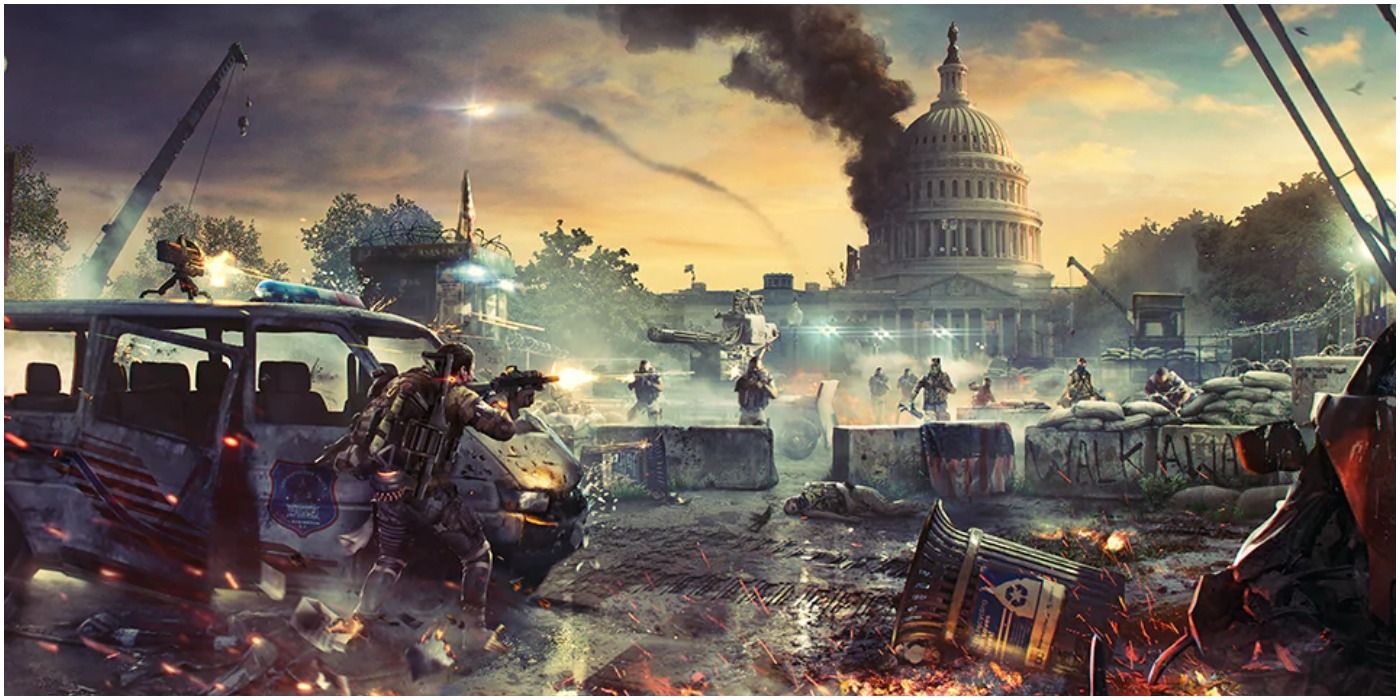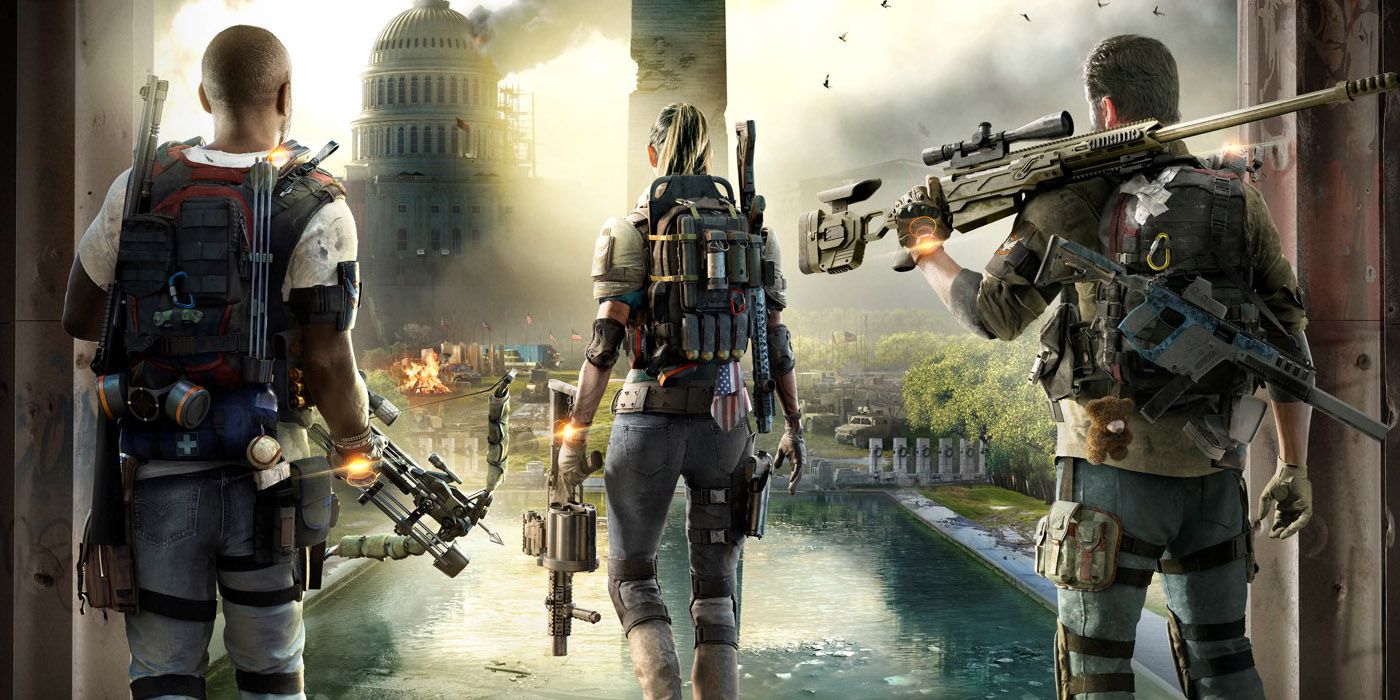Tom Clancy's The Division 2 is moving from New York City to Washington D.C. as part of a drastic shift in location. Massive Entertainment, the lead devs on The Division sequel, had to decide between a few different settings, including New Orleans and Seattle, but they decided that Washington had everything they needed for the game and its story which is set seven months after the original.
The Division 1 was set in New York City during the winter that followed a smallpox outbreak that was spread by a virus. The players controlled a group of Federal Division Agents who were trying to discover the source of the virus and to protect civilians, which involved exploring an urban city setting that had fallen into chaos. The Division 2's timeline sees the game move to a more colorful summer setting and involves a civil war that has broken out in Washington D.C., exacerbated by a heat wave that causes water supplies to dwindle.
Related: Why The Division 2's Dark Zones Are Smaller And Feature Less Players
The developers of The Division 2 had previously mentioned that they looked into using either New Orleans or Seattle as the setting of the game, but they didn't go into detail as to why they chose to go with Washington. Our own Rob Keyes had a chance to interview Yannick Banchereau from Massive Entertainment about The Division 2 and he talked about why they chose Washington as the location for the game.
And when did you land on the decision to go to Washington with the sequel's setting?
Banchereau: New York was a nice city. It was very good for the narrative and the setting. But in terms of gameplay it didn’t necessarily have all the things we wanted, because it was lacking a bit in varied environments and diversity. So, we explored a bunch of different cities. We looked at New Orleans, we looked at Seattle, all of those, those that potentially had a different nature.
But we constantly came back to the idea of Washington DC. (...) So, it's really like, “If we want to up the stakes to be a nationwide issue, Washington makes a lot of sense.” And then exploring the city, we realized that it had everything we wanted, which was very, very different types of environments. This different type of buildings, these very open areas, and these more like enclosed areas. So, it really very quickly became obvious that this was where we wanted to be.
And as for the timing of the game, it's seven months after the first game, and it's summer now as opposed to winter with dull colors in New York.
Banchereau: Yes, absolutely. That was one thing we were also interested with. Which was for us changing the season. Going from the winter and the cold and the snow of the first game, we wanted to have something. But was like, explore the idea of, “Okay, a few months later what happens once the weather gets better, but the infrastructure does not come back.” So, suddenly summer itself becomes an issue as well. Because, when nature is growing, we have actually a heatwave on Washington DC in the storyline and all that. And people are not prepared for it. So, we were very interested in looking at, “Okay, what happens if there is no infrastructure, at least taking care of all the natural side of things?” Like the water. Washington is a city that is by the water. So, if nobody's taking care of all the dams you have and those kinds of things, if nobody's taking care of just the vegetation that is normally in the city, what happens?
We also spoke to Julian Gerighty, the creative director of The Division 2 in order to find out more about the original unused choices for the location of the game.
Gerighty: There were several reasons. Yannick probably went into this, but we had to construct a proposal to head office, Paris, with a rational study of different cities. And we looked at Seattle, New Orleans… New Orleans was, deep down, I felt super interesting. Very cool setting. Very, very different. But we started refining that matrix of rational look at different cities and Washington DC ticked all of these boxes. It had the potential for new stories. It had a very different setup than New York City. As iconic as New York is, it simply doesn't have the variety of different areas that Washington DC does. So, those two things. It's a Clancy game, Washington D.C. is the capital. Just thinking about it, if this virus happened, if there's one city which would have held on, it would've been Washington D.C. And just the fact that it didn't, is an interesting starting point. So, narrative, gameplay, flow, variety of environments, there's a lot of things that lined up for us.
It seems that the choice to move the location of the game from New York City to Washington D.C. was a means of expanding the scope and lore of the game, as they wanted to open up the environments that the player could explore and create large areas in which to battle the enemy without having to rely on enclosed buildings. The change in location also gives the game a more colorful and appealing look, rather than having to rely on rows of buildings that are separated by streets covered in snow, like what we saw in the first game.
More: The Division 2 on PC Releasing on Epic Store Instead of Steam; Specs Revealed
Tom Clancy's The Division 2 releases for PC, PlayStation 4, and Xbox One on March 15th, 2019.


